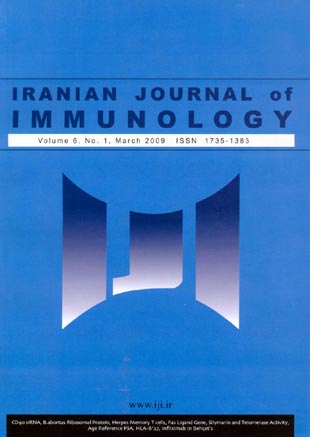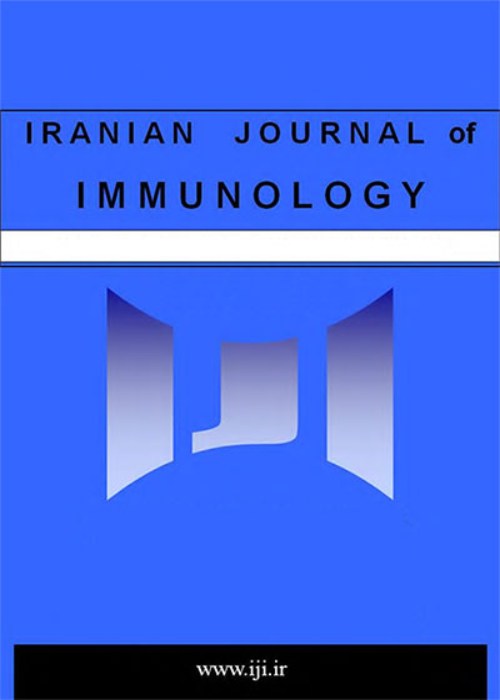فهرست مطالب

Iranian journal of immunology
Volume:6 Issue: 1, Winter 2009
- تاریخ انتشار: 1387/10/11
- تعداد عناوین: 8
-
-
Pages 1-11BackgroundDendritic cells (DCs) are ideal accessory cells in the field of gene therapy. Delivery of DNA and siRNA into mammalian cells is a useful technique in treating various diseases caused by single gene defects. Selective gene silencing by small interfering RNAs (siRNAs) and antisense oligodeoxynucleotides (ODN)s is an efficient method for the manipulation of cellular functions. An efficient, functional delivery system with no toxicity problems would be attractive.ObjectiveWe compared two commercially available cationic lipids, Lipofectamine and FuGENE6, in the delivery of both siRNA and antisense ODNs into mice spleen-derived DCs.MethodsCellular uptake was measured by the means of fluorescein-labelled non-silencing siRNA and antisense ODNs as a model system using flow cytometry. Cytotoxicity of the two delivery systems was compared with propidium iodide and annexin-V staining, and quantified with flow cytometry. The efficiency of our oligonucleotide delivery systems was compared by measuring CD40 expression by flow cytometry.ResultsCD40 expression in DCs was 38%. After siRNA transfection by Lipofectamine, CD40 expression decreased to 13%, and after transfection by FuGENE6, it decreased to 18%. The difference was statistically significant. CD40 down regulation in DCs transfected with the two different antisense sequences by Lipofectamine was 21% and 23%, and down regulation after transfection by FuGENE6 was 19% and 18%, respectively. The differences were not statistically significant. The effects of siRNA and antisense ODNs were specific.ConclusionLipofectamine was a more potent delivery system in siRNA effect, followed by FuGENE6. There was no significant difference between Lipofectamine and FuGENE6 as a delivery system of antisense ODNs.
-
Pages 12-21BackgroundThe immunogenic Brucella abortus ribosomal protein L7/L12 is a promising candidate antigen for the development of subunit vaccines against brucellosis.ObjectiveThis study was aimed to evaluate the protection of recombinant Human Serum Albumin (HAS)-L7/L12 fusion protein in Balb/c mice.MethodsThe amplified L7/L12 gene was cloned in pYHSA5 vector, pYHSA5-L7/L12 construct was transformed in Saccharomyces cerevisiae and the expressed protein from supernatant was purified by affinity chromatography. Balb/c mice were immunized in five groups by tHSA-L7/L12 fusion protein (group 1), Brucella abortus S19 (group 2), HSA (group 3), recombinant L7/L12 (group 4), PBS (group 5). ELISA to detect antibody production, LTT test to assess antigen specific lymphocyte response were conducted prior to virulent B. abortus strain 544 challenge two weeks after the last injection. Bacterial counts from spleens of immunized mice were done four weeks after challenge.ResultsIn ELISA tests, the specific antibodies exhibited a dominance of immunoglobulin IgG1 over IgG2a. In addition, the tHSA-L7/L12 fusion protein and L7/L12 elicited a strong T-cell proliferative response upon restimulation in vitro with recombinant tHSA-L7/L12 and L7/L12, suggesting the induction of a cellular immunity response in vivo. However, there was no significant difference in proliferative response of L7/L12 and tHSA-L7/L12 fusion protein (p>0.05). The L7/L12 and tHSA-L7/L12 fusion protein vaccines could also induce significant protection against challenge with the virulent strain B. abortus 544 in Balb/c mice (p≤0.05).ConclusionThe tHSA-L7/L12 fusion protein, similar to L7/L12 has the ability to induce antigen specific lymphocyte proliferation, stimulate humoral immunity and engender protection.
-
Pages 22-27BackgroundHerpes simplex virus type 1 is one of the most common viruses among human population. Studies demonstrate the essential role of cell mediated immunity, especially CD8+ T cells, in prevention and clearance of HSV1.ObjectiveIt is of great importance to improve our knowledge about the kinetics of CTL responses to primary and secondary HSV-1 infection.MethodsUsing a sensitive technique for detection and analysis of CD8+ T cells, granzyme B ELISA, the CTL activity in the spleens of Balb/c mice at various time points after intraperitoneal administration of HSV1 (strain KOS) in primary and secondary infections were determined.ResultsDuring acute HSV-1 infection, virus specific cytotoxic T cells were detected at day 5 post virus inoculation and peaked at day 7. Six hours after secondary infection the activity of memory CD8+ T cells was detected and peaked at 12 hours post infection.ConclusionThe peak of CTL activity was found to be day 7 post infection in primary HSV-1 infections which decreased with time. In secondary infections, the activity of CTLs reached the highest level at 12 hours post infection.
-
Pages 28-32BackgroundHuman cornea expresses functional Fas-ligand capable of killing Fas+ activated lymphocytes. Fas expression is partly regulated by -670 A/G polymorphism in the promoter region of Fas gene.ObjectiveThe aim of the present study is to determine the association between Fas-670A/G polymorphism and survival of corneal transplantation.MethodsIn 276 graft recipients who mainly underwent penetrating keratoplasty because of keratoconus, bullous keratopathy and corneal opacity, Fas -670 A/G polymorphism was determined by allele specific oligonucleotide polymerase chain reaction (ASO-PCR) techniques.ResultsThere was no statistically significant relationship between Fas -670 A/G polymorphism and rejection episode (p=0.35). Moreover, the relationship between this polymorphism and rejection episode outcome (transplant recovery vs failure) was not statistically significant (p=0.13).ConclusionThe results of the present study show no significant correlation between corneal graft rejection, rejection recovery and Fas -670A/G gene polymorphism.
-
Pages 33-39BackgroundIron is an essential trace element in cell proliferation. Several investigations demonstrate that iron deprivation inhibits cell proliferation. However, the impact of iron on telomerase activity of activated lymphocytes remains unexplained to date.ObjectiveIn this study, the effect of iron on the proliferation and telomerase activity of lymphocytes stimulated by phytohemagglutinin (PHA) were investigated.MethodsIron loading was performed by incubating peripheral blood mononuclear cells in 500μM FeSO4.7H2O for 24 h and iron chelation was done by exposing cells to desferrioxamine, a potent iron chelator. The effects of silymarin, a flavonoid with both antioxidant and iron chelating activities, on the proliferation and telomerase activity of PHA-activated lymphocytes were also compared with desferrioxamine. Proliferation and telomerase activity were assessed using BrdU incorporation assay and Telomeric Repeat Amplification Protocol (TRAP), respectively.ResultsThe proliferations of lymphocytes were significantly inhibited by 10 and 20 μg/ml desferrioxamine in a dose dependent manner, while iron loading recovered suppressed cell proliferation to the normal level. Silymarin at 20 μg/ml significantly increased the proliferation of lymphocytes in both normal and iron-treated conditions. Telomerase activity of lymphocytes was markedly increased by iron treatment and suppressed by desferrioxamine. Conversely, iron treatment had no effect on the telomerase activity of lymphocytes incubated with silymarin.ConclusionIron plays a significant role in the proliferation and telomerase activity of lymphocytes. The effects of silymarin on the proliferation and telomerase activity of lymphocytes were completely different from those of desferrioxamine, suggesting that the immunomodulatory effect of silymarin is probably not associated with its iron chelating activity.
-
Pages 40-48BackgroundIt is relevant to highlight that there is not a precise and perfect report on either 95 percentile value (upper limit of normal range) or on appropriate reference intervals for serum PSA in Iranian population.ObjectiveTo determine age-specific reference ranges for serum prostate-specific antigen (PSA) concentration and PSA density (PSAD) and prostate volumes in a population of healthy Iranian men.MethodsNine-hundred and thirteen healthy Iranian men, aged 50-79 years, underwent a detailed clinical evaluation including a digital rectal examination, a serum PSA determination (DRE) and transrectal ultrasound (TRUS). PSA test was performed on 666 of the subjects and TRUS was done on 633 of them. None of the subjects had any evidence of prostate cancer by any one of the three diagnostic tests and had no history of Lower Urinary Tract Symptoms (LUTS). Age specific ranges for PSA levels, PSA density and prostate volume were determined.ResultsThe serum PSA concentration correlated directly with the subjects’ age (r=0.280; p<0.001) and prostatic volume (r=0.327; p<0.001). Also prostatic volume was directly proportional to age (r=0.197; p<0.001).The serum PSA ranges (95th percentile) for each age range in Iranian men were: 0.00-2.61 ng/ml for 50-59 years; 0.00-3.59 ng/ml for 60-69 years; and 0.00-4.83 ng/ml for 70-79 years. The respective prostate volumes were: 14-59, 16-66 and 18-73ml. Also respective PSA densities were: 0.00-0.076, 0.00-0.10 and 0.00-0.14 ng/ml/ml.ConclusionThe present study confirms earlier reports that serum PSA levels and prostate volume and PSAD are age- and race- dependent, so it is appropriate to have age- specific reference ranges for these variables in various communities around the world. This will increase the positive predictive value of PSA estimation in the diagnosis of prostate cancer in different communities.
-
Pages 49-54BackgroundHLA-B*27 is strongly associated with ankylosing spondylitis (AS). It represents a family of alleles that differ among ethnic groups.ObjectiveThe aim of this study was to determine the distribution of HLA-B*27 alleles in AS patients and healthy controls in Isfahan (Iran).MethodsSixty AS patients and 430 healthy blood donors were selected. All subjects were HLA-B*27 positive by flow cytometry. HLA-B*27 subtypes were determined by PCR-SSP.ResultsForty patients (66.7%) and 17 controls (3.95%) were HLA-B*27 positive. Subtypes detected by PCR-SSP were B*2705, B*2702, B*2704 and B*2707. One patient was B*2702/B*2710. No significant difference was found in the distribution of these alleles between AS patients and controls.ConclusionAlthough Caucasian subtypes are predominant among Iranians, this population is characterized by a combination of both specific Caucasian and Oriental subtypes. However such results should be interpreted carefully because of the small sample size in our investigation and definitive conclusion awaits more ethnic-group studies.


